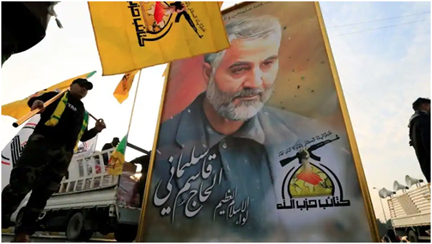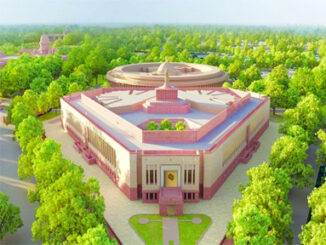
Iranian commander’s killing & US-Iran tension
The beginning of the year 2020 saw a dramatic escalation in hostilities between the US and Iran, after a US drone strike killed Iran’s Revolutionary Guards Corps commander Qassem Soleimani. Soleimani was killed on January 3 in a US drone strike near Baghdad International Airport. Irani media outlets described Soleimani’s killing as an ‘’assassination’’.
Soleimani had disembarked from a plane at Baghdad airport when he was killed in a US drone airstrike. The killing of Iranian commander resulted in Iran’s military “unintentionally” shooting down the Ukrainian jetliner that crashed killing all 176 aboard. The plane was shot down hours after Iran launched a ballistic missile attack on two military bases housing US troops in Iraq in retaliation for the killing of Soleimani. Iranian President Hassan Rouhani, while regretting the mistake committed by Irani’s military, offered his condolences and promised investigations to identify and prosecute this “great tragedy & unforgivable mistake.”
India–China border tension, Galwan Valley clashes
The ties between India and China reached its lowest level due to border dispute in the Himalayan region. The tension between the two world powers aggravated following skirmishes between the two militaries at the border near Pangong Lake in Galwan Valley in eastern Ladakh in May this year. Later, on the intervening night of June 15-16, around 20 Indian soldiers (including an officer) and an undisclosed number of Chinese soldiers died in overnight clashes.
The Galwan Valley clashes – fought with sticks and clubs, not guns – was the first fatal confrontation between the two sides since 1975. In August, India accused China of provoking military tensions at the border twice within a week. Both charges were denied by China, which said the stand-off was “entirely” India’s fault. In early September, China accused India of firing shots at its troops. India accused China of firing into the air. The military tension at the border is mirrored by growing political tension, which has strained ties between Prime Minister Narendra Modi and Chinese President Xi Jinping. As a result of the economic fallout of growing tension, India banned more than 200 Chinese mobile applications, including the hugely popular TikTok, citing security concerns.
Saudi Arabia-Yemen conflict
The unceremonious ouster of pro-Saudi president Abdrabbuh Mansur Hadi had triggered a bitter war between Saudi Arabia and the Houthi rebels in Yemen in 2015. The brutal civil war going on in Yemen has so far claimed more than 16,000 lives and left millions of people on the brink of starvation. The conflict has been dubbed as a “proxy war” among major powers for control in the Middle East as a Saudi-led coalition forces fight rebels backed by Iran.
In a bid to end the conflict, the United Nations intervened in April 2020 and urged both sides to pursue peace talks amid the COVID-19 pandemic. The Saudi-led coalition called a unilateral ceasefire in April, but it carried out dozens of airstrikes within a week. On July 2, the coalition fighter jets launched scores of airstrikes on several Yemeni provinces. The operation was a response to ballistic missile and drone attacks by the Houthi rebels against Saudi Arabia. Both sides have attacked each other since September. The UN had verified the deaths of at least 7,500 civilians by September 2019, with most caused by Saudi-led coalition airstrikes. However, monitoring groups believe the death toll is far higher.
Kurdish forces’ battle Against ISIS
Despite the terror organisation’s defeat in Iraq and Syria, ISIS fighters continue to carry out attacks in border areas. The UN recently said that over 10,000 fighters of the terror outfit are active in both countries and they had stepped up attacks amid the coronavirus pandemic. The US-led coalition’s military assistance to Kurdish forces against the Islamic State (IS) has inadvertently accelerated intra-Kurdish fragmentation.
The present situation requires the US-led coalition must coordinate its aid better, build upon Iraqi Kurdistan’s past efforts in transforming its peshmergas into a professional military, and encourage Kurdish coordination with Iraq’s central government in the fight against IS.
Syrian civil war
The internal fight in Syria began in March 2011 when President Bashar al-Assad faced an unprecedented challenge to his authority after pro-democracy protests erupted throughout the country. The protesters demanded the ouster of the authoritarian Assad regime, which has been in place since Assad’s father, afiz al-Assad, became president in 1971. The Syrian government used violence to suppress demonstrations, making extensive use of police, military, and paramilitary forces. Opposition militias began to form in 2011, and by 2012 the conflict expanded into a full-fledged civil war.
The Syrian civil war that has decimated the country for over nine years, provoking a regional humanitarian crisis, appears to be drawing inexorably to a conclusion. President Bashar al-Assad, with the backing of Iran and Russia, seems to have emerged militarily victorious from the conflict. However, fighting in the country decreased in 2020 following a ceasefire in northwest Syria and the coronavirus pandemic.
The israeli-Palestinian conflict
Despite numerous attempts to resolve the five-decade-old tension between Israel and Palestine, the armed conflict between the two sides continues. According to Human Rights Watch 2020 report, the Israeli government continues to enforce severe and discriminatory restrictions on Palestinians’ human rights, restricting the movement of people and goods in and out of the Gaza Strip. It also facilitates the transfer of Israeli citizens to settlements in occupied West Bank – a practice considered illegal under international humanitarian laws.
Israel’s twelve-year closure of Gaza, exacerbated by Egyptian restrictions on its border with Gaza, limits access to educational, economic and other opportunities, medical care, clean water and electricity for the nearly 2 million Palestinians who live there. Eighty percent of Gaza’s population depend on humanitarian aid.
Armenia-Azerbaijan clashes
In July 2020, armed forces of Armenian and Azerbaijani clashed near Movses in Tavush Province of Armenia, and Agdam in Tovuz District of Azerbaijan at the Armenian-Azerbaijani state border. Both sides accused each other of reigniting the conflict, which erupted at the Ganja gap, which is a strategic route transport corridor for Azerbaijan.
The major reason for the war between Armenia and Azerbaijan is the Nagorno-Karabakh region. Azerbaijan claims this mountainous region as its own, while Armenia has occupied it. The area has been under Armenia’s occupation since the fighting ended in 1994. In 2016 too, there was a bloody war between the two countries over this area, in which 200 people were killed. Now once again both countries are face to face. Both countries were part of the USSR. Both sides have suffered huge casualties and losses due to the ongoing war.
Ukraine crisis
According to Global Conflict Tracker, the crisis in Ukraine began with protests in the capital city of Kiev in November 2013 against Ukrainian President Viktor Yanukovych’s decision to reject a deal for greater economic integration with the European Union. After a violent crackdown by state security forces unintentionally drew an even greater number of protesters and escalated the conflict, President Yanukovych fled the country in February 2014.
In March 2014, Russian troops took control of Ukraine’s Crimean region, before formally annexing the peninsula after residents of Crimea voted to join the Russian Federation in a disputed local referendum. Russian President Vladimir Putin cited the need to protect the rights of Russian citizens and Russian speakers in Crimea and southeast Ukraine. The crisis heightened ethnic divisions, and two months later pro-Russian separatists in the Donetsk and Luhansk regions of eastern Ukraine held a referendum to declare independence from Ukraine.
Violence in eastern Ukraine between Russian-backed separatist forces and the Ukrainian military has by conservative estimates killed more than 10,300 people and injured nearly 24,000 since April 2014. Although Moscow has denied its involvement, Ukraine and NATO have reported the build-up of Russian troops and military equipment near Donetsk and Russian cross-border shelling.
Conflict in Ethiopia’s Tigray
The ongoing armed conflict in Ethiopia’s Tigray began in November 2020. The tensions between Prime Minister Abiy Ahmed’s government in Addis Ababa and leaders from the country’s northern Tigray region came out in the open after the Tigrayan forces clashed with the national military. In early November, Abiy said that Tigrayans had attacked a national military base. He responded by sending troops to the region, which is governed by the Tigray People’s Liberation Front (TPLF) — a political party that once held major influence across the country.
In a televised address days later, Abiy announced that the Ethiopian military had bombed Tigray, destroying weaponry near the regional capital of Mekele. Several days later, hundreds of people were reportedly killed in a knife-and-machete attack in the town of Mai-Kadra, according to Amnesty International. The United Nations human rights office has warned that “there is a risk this situation will spiral totally out of control.





Be the first to comment